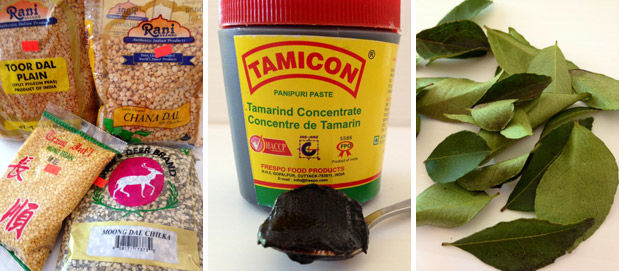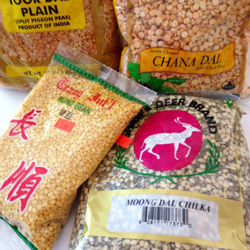When the huge Indian market Ker & Little India closed several years ago on Black Mountain Road, fans of Indian staples and treats were left bereft. There’s still no large shopping destination for Indian products in San Diego, but other stores have picked up some of the slack, offering spices and lentils, and other items crucial to the kitchen. Last year restaurateur Khem Kharel, who has owned several restaurants in Los Angeles and San Diego after emmigrating from his native Nepal, opened both a new restaurant, Himalayan Cuisine, and a little market next door, Himalayan Bazaar, in La Mesa, both of which focus on Indian, Nepalese, and Tibetan food and products.
The market packs a lot in its small space. Here I found a huge selection of dried legumes, spices, packaged curries, packaged naam and roti, dried fruits, chutneys, snacks, and frozen foods. To be honest, the produce isn’t much to look at, but if you’re looking for hard-to-find packaged items from the Himalayan region, this is the place to go. In fact, on the counter is a large loose leaf notebook filled with special requests from customers that Kharel is happy to fill.
Himalayan Bazaar is located at 7918 El Cajon Blvd. in La Mesa.

Food from the Himalayan Bazaar
Lentils
One of the best items on the menu of Himalayan Cuisine is the dal soup. Most dal, which is a preparation of dried lentils, peas, or beans, is more like a stew, eaten with rice and roti (a cracker-like flat bread). This version is looser, but very creamy and rich—the perfect comfort food for a chilly afternoon. You’ll need moong beans ($1.99/14 ounces), toor dal ($4.79/2 pounds), and chana dal or split chick peas ($3.99/2 pounds) to make this dish. Kharel didn’t give me the proportions, but he explained that you combine the three types of legumes in a pot with water, and add just a little oil, salt, and turmeric. Bring to a boil, then simmer until they’re tender—but don’t stir more than to make sure nothing is sticking to the bottom of the pot. When the lentils are tender add more oil, minced garlic, cumin powder, coriander power, ginger, and garam masala. Add more water if necessary and cook for another 10 minutes. And, if you have other dal recipes you want to try, it’s very likely the lentils or other legumes you need will be on the shelves.
Tamarind Concentrate
Last fall I found a dal recipe from Mark Bittman in The New York Times I wanted to try, but it called for tamarind concentrate and I couldn’t find it. When I knew I was going to be checking out Himalayan Bazaar, I put it on my shopping list and, voila, there it was. Tamarind concentrate actually has the look of tar; it’s dense and dark, very sour, and adds the kind of tang you could almost replicate with lime juice, but it’s much more intense. You need just a little to flavor a dal, but you could add a bit to a barbecue sauce, or Thai dishes like pad Thai. $3.99
Fresh Curry Leaves
PARTNER CONTENT
I wasn’t looking for these, but was so delighted when my friend and fellow shopper Lisa Altmann of Viva Pops pointed them out. I bought a bag for a whole 99 cents. The leaves are about the size of a nickel and taste like peppers mixed with citrus. Interestingly, while Himalayan Bazaar focuses on the northern realms of the region, curry leaves are actually integral to the cuisine of southern India—in rice dishes, vegetables, curries, and chutneys. Now, the way I used them was a little more unusual. I brought them over to Gaijin Noodle and Sake House in downtown San Diego, where I was to cook with chef/owner Antonio Friscia and mixologist Lucien Conner. Lucien muddled the leaves with demerara sugar, fresh ginseng, and a kumquat, then added white tequila and grand marnier to make a lovely cocktail we’re still trying to name.
















